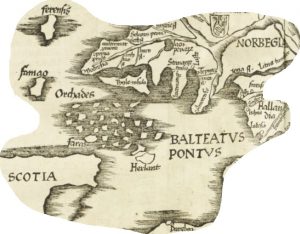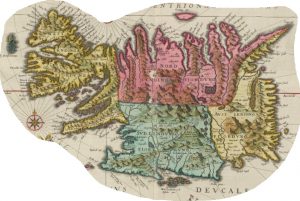
07/05/2024, by aezcr
Orkney in the Viking World
The Viking Age (ca. 750-1100 CE) is the name generally given to a period of population movement out of Scandinavia, leading to raiding, trading, exploration and settlement ranging from the Caspian Sea in the east to Newfoundland in the west. The term ‘viking’ is used for the Scandinavian peoples who made these voyages, as well as for many of their associates from other regions who joined in these activities along the way.
In the west, these movements led to well-documented raids across Britain and Ireland, especially in the ninth and tenth centuries, followed by the establishment of permanent settlements in eastern and northern England, and in many areas of Scotland, Wales and Ireland. The establishment in these islands of populations speaking a Scandinavian language and maintaining a Scandinavian culture through contact with both their homelands and other similar settlements led to what is sometimes called the Viking diaspora, a complex linguistic, cultural and political network across the North Sea and the North Atlantic.
The diaspora helped to maintain Scandinavian language and culture in the settlements in the west until those in Britain and Ireland were gradually assimilated into the local languages, cultures and polities. A completely new polity was established in previously uninhabited Iceland in the late ninth century, where the language has continued in use into the present day and where many of our written sources for Scandinavian culture and history were produced from the twelfth century onwards.

Detail from Ptolemy’s map of ‘Norbegiae et Gottiae’, 1525, showing the north of Scotland, Orkney, and Norway. Reproduced with the permission of the National Library of Scotland.
 The concept of diaspora is particularly relevant to Scotland, where large parts of its north and west came under the jurisdiction of the kingdom of Norway in the Viking Age and later under that of Denmark. The Hebrides (Western Isles) were ruled by Norway until 1266 while the Northern Isles (Orkney and Shetland) did not become a part of Scotland until the middle of the fifteenth century. The Viking Age earldom included Shetland, Caithness and Sutherland as well as Orkney but was bit by bit incorporated into the kingdom of Scotland. This process was complete in 1468-9 when Orkney and Shetland were pledged by King Christian I of Denmark and Norway, as security for the dowry of his daughter Margaret, who was betrothed to James III of Scotland. The dowry was never paid, the islands were soon annexed and they have been a part of Scotland ever since.
The concept of diaspora is particularly relevant to Scotland, where large parts of its north and west came under the jurisdiction of the kingdom of Norway in the Viking Age and later under that of Denmark. The Hebrides (Western Isles) were ruled by Norway until 1266 while the Northern Isles (Orkney and Shetland) did not become a part of Scotland until the middle of the fifteenth century. The Viking Age earldom included Shetland, Caithness and Sutherland as well as Orkney but was bit by bit incorporated into the kingdom of Scotland. This process was complete in 1468-9 when Orkney and Shetland were pledged by King Christian I of Denmark and Norway, as security for the dowry of his daughter Margaret, who was betrothed to James III of Scotland. The dowry was never paid, the islands were soon annexed and they have been a part of Scotland ever since.

Detail from Blaeu’s ‘Atlas Maior’, 1662-5, showing Orkney. Reproduced with the permission of the National Library of Scotland.
The Saga of the Earls of Orkney tells the history of the Norse earls up until the early thirteenth century and is a crucial source for understanding Scandinavian Scotland. Other important evidence for both the Viking and Late Norse periods in Scotland comes from archaeology, place-names, language history and runic inscriptions.
Judith Jesch.
Further reading
Tom Horne, Elizabeth Pierce, Rachel Barrowman (eds), The Viking Age in Scotland (Edinburgh University Press, 2023)
Judith Jesch, The Viking Diaspora (Routledge, 2015)


There’s quite a bit about Orkney between Scotland and Scandinavia after 1468-9 in a recent book by Peter Marshall, Storm’s Edge (William Collins, 2024) and he also has a useful article in the May 2024 issue of History Today.